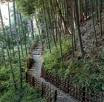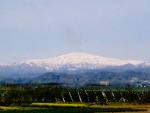::::::::::::::::::::::::::::::::::::::::::::::::::::::::::::::::::::::::::::::::::::::::::::::::::::::::::::::::::::::::::::::::::::::::::::::::::::::::::::::::::::::::::::::::::::::::::::::::::::::::::::
- Oku no Hosomichi - 奥の細道 - おくのほそ道
The Narrow Road to the Deep North -
. Oku no Hosomichi - 奥の細道 - Introduction .
::::::::::::::::::::::::::::::::::::::::::::::::::::::::::::::::::::::::::::::::::::::::::::::::::::::::::::::::::::::::::::::::::::::::::::::::::::::::::::::::::::::::::::::::::::::::::::::::::::::::::::

The landscape Basho describes has changed very much since the huge earthquake of 1804.
- - - Station 32 - Kisagata / Kisakata 象潟 - - -
I had seen since my departure innumerable examples of natural beauty which land and water, mountains and rivers, had produced in one accord, and yet in no way could I suppress the great urge I had in my mind to see the miraculous beauty of Kisagata, a lagoon situated to the northeast of Sakata.* I followed a narrow trail for about ten miles, climbing steep hills, descending to rocky shores, or pushing through sandy beaches, but just about the time the dim sun was nearing the horizon, a strong wind arose from the sea, blowing up fine grains of sand, and rain, too, began to spread a grey film of cloud across the sky, so that even Mount Chokai was made invisible. I walked in this state of semi-blindness, picturing all sorts of views to myself, till at last I put up at a fisherman's hut, convinced that if there was so much beauty in the dark rain, much more was promised by fair weather.
A clear sky and brilliant sun greeted my eyes on the following morning, and I sailed across the lagoon in an open boat. I first stopped at a tiny island named after the Priest Noin to have a look at his retreat where he had stayed for three years, and then landed on the opposite shore where there was the aged cherry tree which Saigyo honored by writing 'sailing over the waves of blossoms. There was also a mausoleum of the Empress Jingu and the temple named Kanmanjuji.
I was a bit surprised to hear of her visit here and left in doubt as to its historical truth, but I sat in a spacious room of the temple to command the entire view of the lagoon. When he hanging screens were rolled up, an extraordinary view unfolded itself before my eyes - Mount Chokai supporting the sky like a pillar in the south with its shadowy reflection in the water, the barrier-gate of Muyamuya just visible in the west, an endless causeway leading as far as Akita in the east, and finally in the north, Shiogoshi, the mouth of the lagoon with waves of the outer ocean breaking against it. Although little more than a mile in width, this lagoon is not the least inferior to Matsushima in charm and grace. There is, however, a remarkable difference between the two. Matsushima is a cheerful, laughing beauty, while the charm of Kisagata is in the beauty of its weeping countenance. It is not only lonely but also penitent, as it were, for some unknown evil. Indeed, it has a striking resemblance to the expression of a troubled mind.
A flowering silk tree
In the sleepy rain of Kisagata
Reminds me of Lady Seishi
In sorrowful lament.
Cranes hop around
On the watery beach of Shiogoshi
Dabbling their long legs
In the cool tide of the sea.
What special delicacy
Is served here, I wonder,
Coming to Kisagata
On a festival day
- Written by Sora
Sitting at full ease
On the doors of their huts,
The fishermen enjoy
A cool evening
- Written by Teiji
A poem for a pair of faithful osprey nesting on a rock:
What divine instinct
Has taught these birds
No waves swell so high
As to swamp their home?
- Written by Sora
Tr. by Nobuyuki Yuasa
source : terebess.hu/english

象潟
江山水陸の風光数を尽して今象潟に方寸を責。酒田の湊より東北の方、山を越、礒を伝ひ、いさごをふみて、其際十里、日影やゝかたぶく比、汐風真砂を吹上、雨朦朧として鳥海の山かくる。闇中に莫作して、雨も又奇也とせば、雨後の晴色又頼母敷と、蜑の苫屋に膝をいれて雨の晴を待。
其朝、天能霽て、朝日花やかにさし出る程に、象潟に舟をうかぶ。先能因嶋に舟をよせて、三年幽居の跡をとぶらひ、むかふの岸に舟をあがれば、花の上こぐとよまれし桜の老木、西行法師の記念をのこす。江上に御陵あり。神功后宮の御墓と云。寺を干満珠寺と云。比處に行幸ありし事いまだ聞ず。いかなる事にや。此寺の方丈に座して簾を捲ば、風景一眼の中に尽て、南に鳥海天をさゝえ、其陰うつりて江にあり。西はむや/\の関路をかぎり、東に堤を築て秋田にかよふ道遥に、海北にかまえて浪打入る所を汐こしと云。江の縦横一里ばかり、俤松嶋にかよひて又異なり。松嶋は笑ふが如く、象潟はうらむがごとし。寂しさに悲しみをくはえて、地勢魂をなやますに似たり。
象潟や雨に西施がねぶの花 - Kisakata Ya ame ni Seishi ga nebu no hana
汐越や鶴はぎぬれて海涼し - shiogoshi ya tsuru hagi nurete umi suzushi
祭礼
象潟や料理何くふ神祭 曾良 - Sora - Kisakata ya ryoori nani kuu kami matsuri
蜑の家や戸板を敷て夕涼 みのゝ国の商人低
岩上に雎鳩の巣をみる
波こえぬ契ありてやみさごの巣 曾良 - Sora
::::::::::::::::::::::::::::::::::::::::::::::::::::::::::::::::::::::::::::::::::::::::::::::::::::::::::::::::::::::::::::::::::::::::::::::::::::::::::::::::::::::::::::::::::::::::::::::::::::::::::::

Screen of Kisakata and Mount Chokaisan before the earthquake
鳥海山 - 象潟の古景図
source : city.nikaho.akita.jp
Japan 1804:
Kisakata earthquake on July 10, magnitude of 7.3. and killed 450 people .
::::::::::::::::::::::::::::::::::::::::::::::::::::::::::::::::::::::::::::::::::::::::::::::::::::::::::::::::::::::::::::::::::::::::::::::::::::::::::::::::::::::::::::::::::::::::::::::::::::::::::::
Kisakata ya ryoori nani kuu kami matsuri
Oh now Kisakata !
What special food do they eat
at the shrine festival?
Kisakata an einem Festtag!
Was es hier wohl für
Spezialitäten gibt?
The "Special delicacy" mentioned by Sora,
in a hokku by Basho:
めずらしや山を出羽の初なすび
mezurashi ya yama o Dewa no hatsu nasubi
how wonderful and extraordinary !
coming out of the sacred Dewa mountains
to these first eggplants
Welche Überraschung!
aus den Heiligen Bergen von Dewa kommend
hier die ersten Augerginen
"After we confined ourself in Haguro-Sanzan Shrine to pray for seven days, we have come down to Tsuruoka Town. Then we are given a warm welcome at Nagayama Juko's residence. How delicious the new eggplants are at the dinner."
Matsuo Basho at Sakata
With a memorial marker :
. Food from Yamagata .
::::::::::::::::::::::::::::::::::::::::::::::::::::::::::::::::::::::::::::::::::::::::::::::::::::::::::::::::::::::::::::::::::::::::::::::::::::::::::::::::::::::::::::::::::::::::::::::::::::::::::::
. Nōin、Nooin Hoshi, No-In Hoshi 能因法師 Priest No-In .
(988-1051)
::::::::::::::::::::::::::::::::::::::::::::::::::::::::::::::::::::::::::::::::::::::::::::::::::::::::::::::::::::::::::::::::::::::::::::::::::::::::::::::::::::::::::::::::::::::::::::::::::::::::::::
Kisakata ya ame ni Seishi ga nebu no hana
Kisakata ―
Seishi sleeping in the rain,
Wet mimosa blossoms
Tr. Donald Keene
MORE
source : akitahaiku.com
..........................................................................................................................................................
Shiogoshi - Shiokoshi 塩越 - 汐越 a station along the road between Sendai and Dewa
Sendai Kaidoo 出羽仙台街道
羽後街道 broke off from Yoshioka 吉岡 leading to Iwadeyama 岩出山.

汐越や鶴脛ぬれて海涼し
shiogoshi ya tsuru hagi nurete umi suzushi
the Shallows—
a crane with legs wet,
the sea cool
Tr. Barnhill
Tide-Crossing -
The crane’s long legs are wetted
How cool the sea is!
Tr. Donald Keene
. 汐越の松 Shiokoshi no Matsu .
at - - - Station 38 - Daishoji 大聖寺 (Daishooji) - - -
- - Reference - Kisakata Japan - -
::::::::::::::::::::::::::::::::::::::::::::::::::::::::::::::::::::::::::::::::::::::::::::::::::::::::::::::::::::::::::::::::::::::::::::::::::::::::::::::::::::::::::::::::::::::::::::::::::::::::::::
- - - - - The famous waka by Saigyo :
象潟の桜は波に埋れて花の上漕ぐ海士の釣り舟
Kisagata no sakura wa nami ni uzumorete hana no ue kogu ama no tsuribune
At Kisakata
a cherry tree is covered
at times by the waves;
fishermen must row their boats
above the cherry blossoms.
Tr. Keene
The cherry blossoms
of Kisagata are buried
in the waves -
a fisherman's boat
rowing over the flowers.
Tr. Shirane
. Basho and Saigyo 芭蕉と西行法師 .
Also in the following poem from Kisagata, Basho is reminded of Saigyo:
夕晴や桜に涼む波の花
yuubare ya sakura ni suzumu nami no hana
clearing at evening -
cool now under the cherry trees
blossoms on the waves
Tr. Chilcott
元禄2年4月.
nami no hana 波の花 / 波の華 is also an expression for the foam that builds on the surf during strong winds in winter along the beaches of the Nihonkai.
::::::::::::::::::::::::::::::::::::::::::::::::::::::::::::::::::::::::::::::::::::::::::::::::::::::::::::::::::::::::::::::::::::::::::::::::::::::::::::::::::::::::::::::::::::::::::::::::::::::::::::

. WKD : Kobayashi Issa 小林一茶 in Edo .
象がたを鳴なくしけりきりぎりす
kisagata o naku-nakushi keri kirigirisu
crickets crying
as they lose everything --
Kisakata Bay
Tr. Chris Drake
This hokku was written in the 8th month (September) of 1811, when Issa was in the area east of Edo and seven years after the great Kisakata earthquake of July 10, 1804. Before the earthquake, Kisakata Bay on the Japan Sea coast far to the northwest of Edo was regarded as one of the most beautiful shoreline areas in Japan, ranking with Matsushima on the Pacific coast (which was largely spared by the recent great earthquake). More than a hundred small islands in various unusual shapes left by earlier volcanic eruptions rose from the shallow water of the small bay, much of which was a lagoon sheltered from sea waves by a long, thin spit of land. Black pines grew on the islands, and several islands had small Buddhist temples or Shinto shrines on them, giving the bay an almost unworldly beauty.
Basho of course visited the area and wrote a poem there, as had many other poets over the centuries. Then, in 1804, a very large earthquake suddenly raised the bay more than two meters, leaving the bottom of the bay above sea level. The area became a freshwater marsh, and soon it was covered by fertile rice paddies dotted with small rocky hills that were once islands.
Issa no doubt read and heard about the shocking change in the landscape and, hearing crickets near Edo, he imagines the sorrow of all the creatures living in Kisakata, even the crickets. The verb 'cry' in Japanese has the same double meaning of to make a sound and to weep that the verb has in English, and there is surely sorrow in the sounds made by these crickets. Issa also overlaps the sound of the verb 'to cry' (naki) with the sound of a normally unrelated verb, 'to lose, be bereft of' (nakushi-) to make them reverberate together. He turns the strength of the crickets' cries into an indication of the depth of their feeling of loss: the crickets -- and human readers -- only realize how much they've lost as they cry out. The disappearance of the apparently eternal bay has made the former bay similar in one sense to the short-lived bodies of crickets (and humans), and it suggests that the crickets are crying for themselves as well.
* For Basho, Buson, Issa, and all "premodern" Japanese writers, kirigirisu meant crickets. However, in modern Japanese the meaning of this word has changed, and it now refers to katydids or grasshoppers, and another word, koorogi, now means crickets.
MORE
. Chris Drake commenting on Issa - Kisakata .
象潟や桜を浴てなく蛙
kisagata ya sakura o abite naku kawazu
Kisa Lagoon--
bathing in cherry blossoms
croaking frog
Tr. David Lanoue
Kisakata Today
source : ee4y-nsn/oku/ksgaa01
- the 99 islands 秋田象潟・九十九島
source : www.uchinome.jp

象潟と文学 (Kisakata in Japanese literature)
source : www10.plala.or.jp/tokuda_shusei
::::::::::::::::::::::::::::::::::::::::::::::::::::::::::::::::::::::::::::::::::::::::::::::::::::::::::::::::::::::::::::::::::::::::::::::::::::::::::::::::::::::::::::::::::::::::::::::::::::::::::::
I visited the region and temple Kanman-Ji 蚶満寺 many years back, it is very impressive indeed, with all the former islands now sticking out as small hills.
Kanmanji 虫甘満寺 / 蚶満寺 the Temple Kanman-Ji
The first Kanji character ‘虫甘’ means ‘赤貝(akagai), ark shells”. . . lit.虫甘 "insect that tasts sweet", an old Chinese character 蚶 for the ark shell.
Kanmanji is surrounded by a sacred grove of old-growth laurel trees (tabunoki たぶのき【椨】 Persea thunbergii or Machilus thunbergii).
BACK TO
. Oku no Hosomichi - 奥の細道 - Introduction .
[ . BACK to DARUMA MUSEUM TOP . ]
[ . BACK to WORLDKIGO . TOP . ]
:::::::::::::::::::::::::::::::::::::::::::::::::::::::::::::::::::::::::::::::::::::::::::::::::::::





































